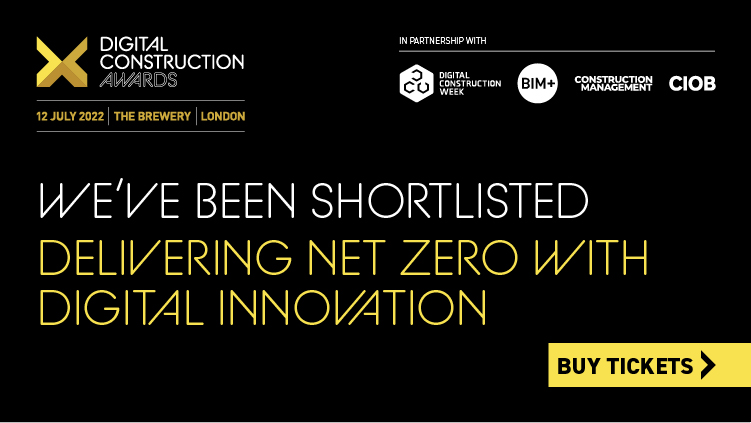The Digital Construction Awards attracted more than 120 entries, 63 of which have been shortlisted. Here, we detail the Delivering Net Zero with Digital Innovation shortlist.
This category recognises those organisations whose vision of the future is an industry that places great importance on carbon efficiency. Six entries made the shortlist:
51 Moorgate | Skanska UK
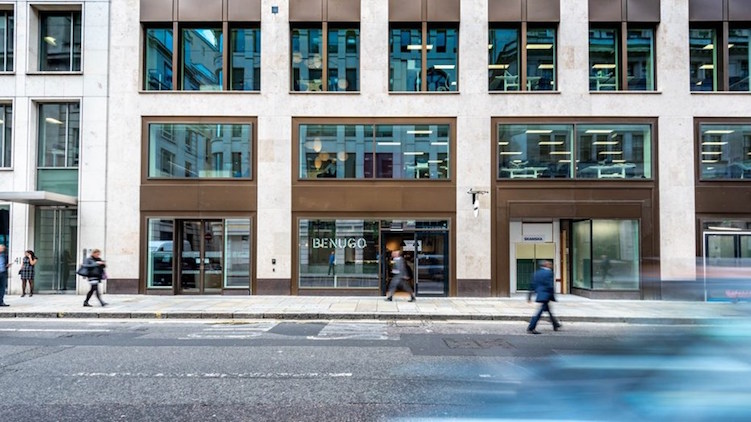
Skanska has developed its own intelligent buildings platform and service and deployed it to its head office within London, 51 Moorgate.
The platform and service use a custom-developed digital platform to collect, analyse and act upon real-time data to improve building performance focusing on carbon, operational efficiency, and productivity.
Data is displayed in dashboards for carbon, operational efficiency, and productivity, using a variety of graphs, charts and tables. The digital twin is also hosted within the platform. Through the platform, Skanska can offer a service remotely to control all the assets that are monitored
The platform is a software-agnostic solution that can interoperate with other technologies.
Since the platform’s introduction at 51 Moorgate, energy use has been reduced by more than 40%, and FM by 8%. This is through using data to drive energy savings within specific control systems, and by reducing the labour time on site required for FM.
ARES Prism cost & carbon estimation and management | ARES Prism with the Environment Agency and Aecom
The Environment Agency (EA) is delivering an unprecedented £5.2bn capital investment programme by March 2027. It is also committed to achieving net-zero carbon by 2030 but needed a way to estimate and track projects’ whole-life carbon and cost.
ARES Prism reworked its project estimating and cost management software to enable the EA to be able to set target pricing with associated carbon values for construction projects. Existing in-house cost data previously did not meet the accuracy criteria, and the commitment to net zero by 2030 requires an accurate and efficient method of setting carbon baselines and measuring progress against targets, alongside target price setting.
The overhauled system automatically collects the relevant inputs from the construction estimate and allows the user to input operational and end-of-life variable values, which are used to produce a lifecycle carbon assessment over 100 years, according to the EA’s established ERIC methodology.
Carbon reduction plans: an exercise | Lynch with Skanska Costain Strabag JV
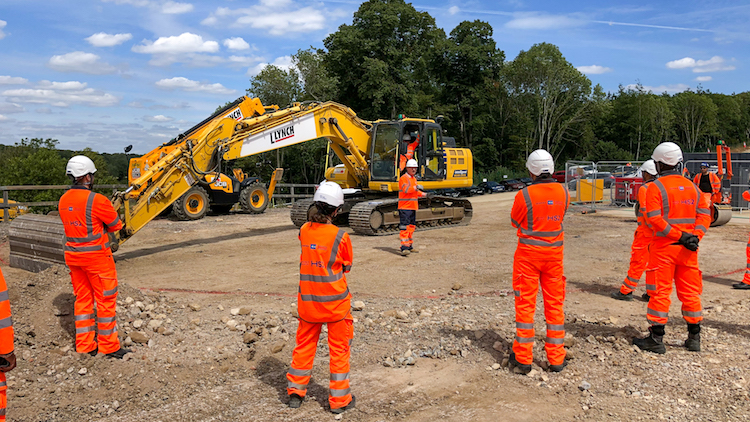
Lynch Plant Hire’s client on HS2, SCS JV (Skanska, Costain, Strabag), asked it to reduce plant idling by 20% to improve the air quality for the community surrounding the construction site.
Lynch looked at its available resources, namely technology, data and its people. The development of its strategy began with its Eco Driver Training Programme, which blended telematics data with advanced operator training.
It educated its operators on the importance of sustainable working and how they can impact fuel consumption and carbon emissions. Using telemetry data, Lynch tracked the results of the training month by month and provided direct feedback to each individual driver.
The overall goal was to move the driver idling percentage from red (above 60%), to amber (between 41% and 59%) and then to green (below 40%). Following the success of the programme, Lynch has made Eco Driver Training a mandatory module for all operators.
Combining IoT with BIM to create a digital twin environment | ONE Creative Environments
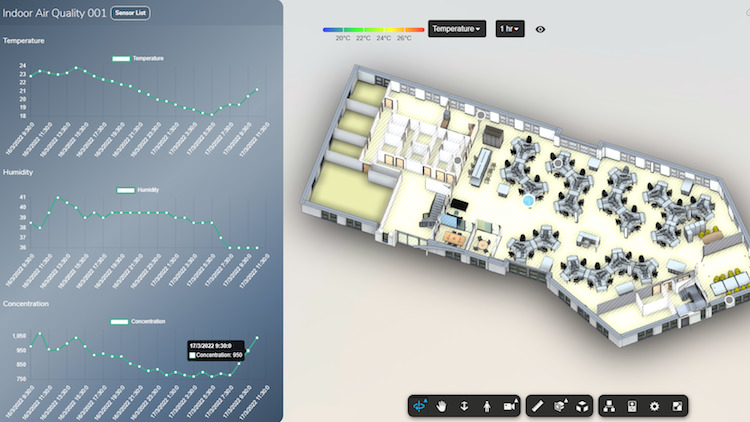
You cannot ‘Google’ a simple method of “how to create a digital twin”. This prompted ONE to undertake an R&D project to understand and simplify the creation of digital twins.
ONE created a workflow that simplifies the connection of IoT sensors to 3D models, creating a digital twin platform with fully configurable tools to provide a range of benefits including carbon reduction, energy management, improved wellbeing and safety, and unlocking operational benefits from BIM and digital information management.
To deliver this project, ONE recruited new facilities management and software programming staff into its specialist BIM deliverables team. The project has resulted in the emergence of its new Digital Estates team to provide digital twin services and improve performance of its clients’ assets.
EOC ECO2 | Eckersley O’Callaghan
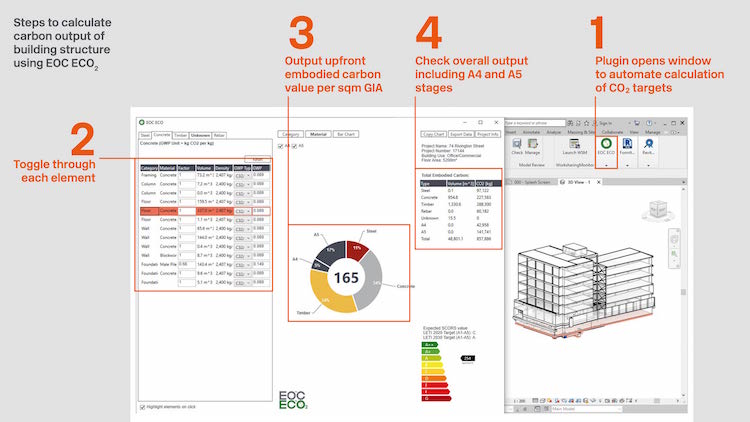
The average consultant engineer can contribute 1,000 tonnes of CO2 in a year. In 2019, as signatories of the Engineers Declare movement, Eckersley O’Callaghan pledged to record carbon emissions for every building project.
To understand the scale of the challenge ahead, the company needed to find a way of retrospectively measuring its completed projects. Since almost all its projects were modelled using BIM, its digital design team developed a scripted plug-in to be used in Autodesk Revit.
The software gives a breakdown of the embodied carbon output for the structural materials used in a building. The tool extracts all the volumes of Revit elements and applies a default carbon value based on each element’s specification.
This has allowed Eckersley O’Callaghan to calculate the embodied carbon of its past and current projects and benchmark this against targets such as LETI. This helps inform its approach on projects and provides the data and knowledge required to accurately advise clients on structural approaches that need to be adopted to work towards achieving net-zero targets.
Printfrastructure: low carbon, graphene enhanced 3D construction printing for HS2 | Skanska Costain Strabag JV with HS2 Innovation Programme and ChangeMaker 3D
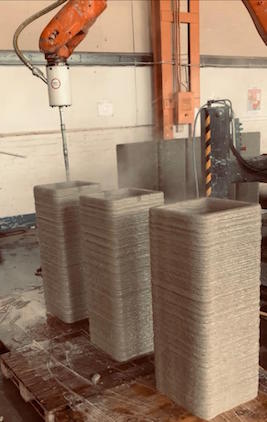
Printfrastructure is a collaboration between SCS JV (Skanska, Costain and Strabag), HS2, ChangeMaker 3D and its supply chain to leverage 3D construction printing to reduce carbon and leave a lighter footprint on the planet.
The project seeks to demonstrate the sustainability benefits of using less material and therefore reducing waste, using eco-materials and taking steps out of the construction process by using 3D robotic printers.
Early phases of the project showed that the printing of both temporary and permanent retaining walls for HS2 represented a route to scale up the technology. A comparison of digital construction printing designs compared to traditional structures showed a 90% reduction in the use of rebar and a 28% carbon reduction, with safety benefits.
That led to a second phase in February 2022 with full-scale printing of wall structures, which are soon to be tested by BRE.
The fourth phase of the project aims to act as a catalyst to fully exploit the 3D construction printing capability across the HS2 programme.
Celebrate with the best
The winners of the Delivering Net Zero category, alongside the victors of the other 11 categories, will be revealed at the awards dinner on 12 July at the Brewery in London.
You can join them by booking your places at the awards. There is an early bird discount of 20% for those who book tables before 5pm on 20 May.
The Digital Construction Awards celebrate best practice and reward innovation in the application of BIM and digital technology in the built environment sector.
The awards are run by Digital Construction Week, the Chartered Institute of Building, and media titles Construction Management and BIMplus.
Awards sponsors include Revizto, Bluebeam, Procore, Autodesk, Solibri and the Association for Project Safety.
Don’t miss out on BIM and digital construction news: sign up to receive the BIMplus newsletter.



